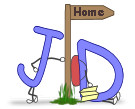
|
<<Back |
Nürnberg,
Germany
December
10, 2008 |
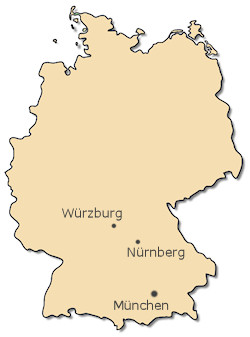
|
|
|
| Since D’s parents were unable
to make their 50th anniversary cruise of the Greek
Isles, we decided to pay them a pre-Christmas
visit to see how they were doing. We hadn’t been to
Germany since the 2006
World Cup, and we decided to get into the spirit
of the season by experiencing a Christmas market.
D’s aunt lives in Würzburg, so it made sense
to combine a day of catching up with family and a
day visiting one of Germany’s best known holiday markets
in Nürnberg. So after a half-day on the train,
lunch in the Ratskeller, the obligatory kaffeeklatsch
to catch up on family matters, and an evening strolling
around Würzburg, we were on our way the next
morning to see the sights of Nürnberg.
|
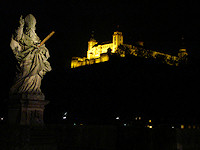
A night scene of St. Kilian
and the Festung Marienberg in Würzburg.
|
|
|
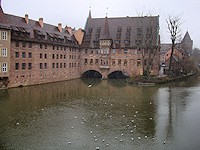
Heilig-Geist-Spital on the Pegnitz.
|
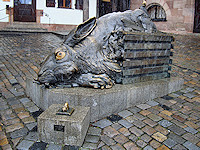
Dürer's rabbit.
|
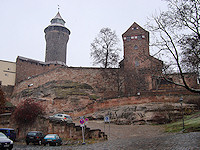
The castle at Nürnberg.
|
|
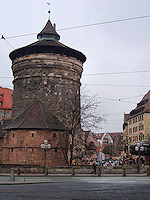
Königstor.
|
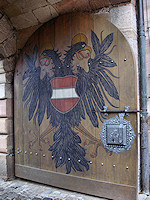
Castle courtyard entrance.
|
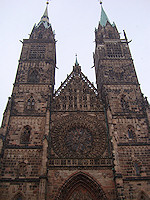
St. Lorenz church.
|

Dürerhaus.
|
|
|
To most people, the history
of Nürnberg (anglicized to Nuremberg)
will forever be entwined with the Third Reich and
World War II. However, the importance of the city
from an historical perspective dates back to the First
Reich. In the middle ages, it was generally regarded
as the capital of the Holy Roman Empire, a conglomeration
of central European states formed from Charlemagne’s
kingdom. For five hundred years, Nürnberg was
the site of the empire’s administrative gatherings
called reichstage which were held in the
city’s castle beginning in 1050. The emperors themselves
were required by law to occupy the castle during these
congresses leading to it being called the Kaiserburg.
Nürnberg flourished during
this period as it sat along a major trade route between
Italy and northern Europe. It was also granted status
as an Imperial Free City meaning that it answered
only to the Holy Roman Emperor. The city became a
center for trades such as printing and toymaking but
also for art and science due in part to the presence
of Albrecht Dürer who was seen as the "DaVinci
of the North". Dürer was born in Nürnberg
and made contributions in astronomy, geometry, anatomy,
painting, engraving, and printing – a true Renaissance
man. The Thirty Years War initiated a decline in the
city’s influence which eventually culminated in Napoleon’s
decision to put it under Bavarian control.
In addition to the castle that
overlooks the city, Nürnberg is surrounded by
impressive city walls, much of which is still standing.
The city was an important manufacturing site of engines
for airplanes and tanks during World War II, and it
therefore suffered severe bombing which destroyed
about 90% of the old city. Most of the historic parts
have since been rebuilt to their pre-war appearance,
but the area near the castle known as the Burgviertel
remained relatively unscathed. This section of town
still retains its medieval charm with narrow cobblestone
streets and half-timber houses. This is where the
Albrecht-Dürer-Haus has been preserved with a
number of the artist’s woodcuts, paintings, and etchings.
|
|
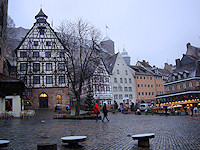
Dürerplatz in the Burgviertel.
|
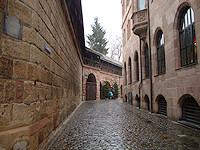
Nürnberg's city walls.
|
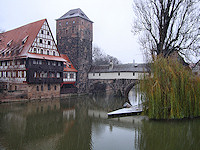
Henkersteg.
|
|
|
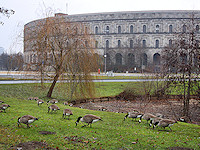
The Congress Hall.
|
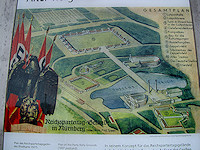
Speer's ultimate plan.
|
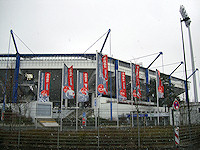
Home of "Der Club".
|
|
| 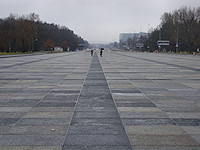
The Grosse Strasse.
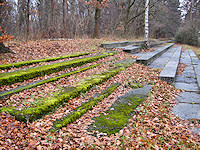
Remnants of the viewing area
that lined the Grosse Strasse.
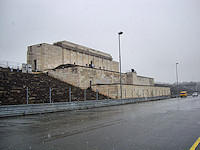
The Zepplintribune.
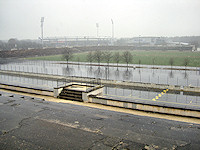
A view across the Zepplinfeld.
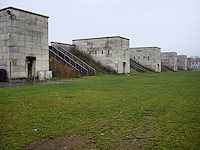
Towers that supported spotlights surrounding the Zepplinfeld.
|
Signs of Nürnberg’s nefarious
past can be seen southeast of the city in a park called
the Volkspark Dutzendteich. Hitler regarded Nürnberg
as the most German city in the Reich owing to its
geographical location and of course its central role
in German history. It was also the hometown of Julius
Streicher, one of Hitler’s earliest supporters, and
had a history of anti-Semitism as evidenced by several
purges of Jewish inhabitants during its history. In
fact the Reichtag issued new laws from Nürnberg
in 1935 that defined the German race and revoked the
German citizenship of Jews. Many of these reasons
contributed to Hitler’s decision to make Nürnberg
a showpiece of National Socialism.
As early as 1927, Nürnberg
hosted the Nazi party congress, a gathering of party
officials and members from all over Germany in a celebration
of their allegiance to the Third Reich. Once the National
Socialist Party ruled Germany, the congresses were
held annually in Nürnberg, and attendance steadily
climbed to the point that the rallies were moved to
accommodate the growing crowd. Hitler tapped Albert
Speer to create a grandiose complex called the Reichsparteitagsgelände
to host the rallies and to last as long as the Thousand
Year Reich. Speer’s plans called for incorporating
the existing Ehrenhalle, a World War I memorial, into
a large gathering area called the Luitpoldarena with
a capacity for 150,000 people.
Just to the east of the Ehrenhalle
is the largest structure of the complex that is still
standing. Though modeled after the Coliseum in Rome,
the Kongresshalle would have been twice the size.
It was intended as a meeting hall to accommodate 50,000
people; however, the top levels and roof were never
completed because of the war. Today, it is preserved
as the largest building of the Nazi era that remains
and houses a museum dedicated to remembering the horrors
and implications of National Socialism. Outside of
the Kongresshalle is the starting point of the Grosse
Strasse (Great Street), a 200 ft wide and one mile
long granite thoroughfare that bisected the complex.
Steps built on either side were meant to serve as
bleachers for crowds to watch the military processions
held here. Only three quarters of the road was ever
completed, and it is currently used as a parking lot
for events.
Heading north from the Grosse
Strasse, we came to the remnants of the Zeppelinfeld.
This one time park where one of Graf Zeppelin’s airships
once landed was converted by Speer into a massive
parade ground fronted by a granite grandstand from
which the Führer addressed his followers. Surrounding
the field were concrete towers that contained restrooms
and supported the 150 spotlights used during nighttime
rallies. Speer had the lights arranged so that they
pointed straight up into the darkness thereby causing
the facility to appear as a "cathedral of light"
when illuminated. All these lights needed power, so
a power substation was built behind the Zeppelintribune.
We swung around behind the railroad tracks to take
a look and found that it is now a Burger King, yet
the traces of a Nazi eagle emblem are still visible.
Two major projects at the grounds
never neared completion. Speer's plans included a
parade ground called the Märzfeld that would
be larger than 80 football fields and surrounded by
spectator stands. An even loftier undertaking was
the Deutches Stadion (German Stadium) which was to
hold 400,000 spectators and was by order of the Führer
to host all future Olympic Games. The demands of the
war halted both projects, and many of structures were
either demolished during the Allied occupation or
years after for public safety reasons.
High-ranking Nazi officials
returned one last time to Nürnberg in 1945 when
they faced an international tribunal to be tried for
war crimes. The Allied forces chose Nürnberg
specifically for its location in the American occupied
zone, its spacious courthouse, and its symbolism as
a Third Reich showpiece. Albert Speer, architect of
the Reichsparteitagsgelände, avoided the hangman’s
noose, although convicted of using slave labor, and
instead served a 20 year prison sentence.
|
|
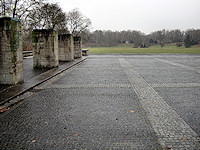
At the Ehrenhalle.
|
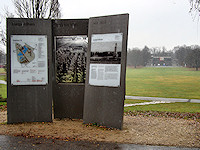
The Luitpold arena - then and
now.
|
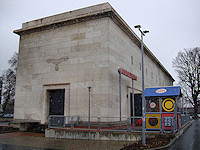
You have to love the irony.
|
|
|
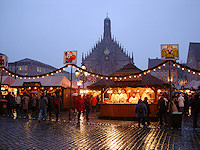
Mmmmm... Nürnbergwürstchen.
|
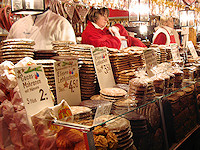
Lebkuchen peddlers.
|
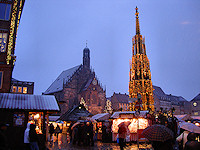
The Shöner Brunnen and
Frauenkirche.
|
|
|
As we toured the Rechsparteitagsgelände,
it began to snow – the kind that is heavy and wet.
By the time we returned to the Altstadt, we were both
very cold and wet. We thawed out in a stube
with hot coffee, a bowl of soup, and some rotbier
– a Nürnberger specialty. We were holding out
for the evening’s main event, the Christmas market,
which would surely provide plenty of warm glühwein,
Nürnberger würstchen, and gebrannte
mandeln. Although Nürnberg is particulary
known for its lebkuchen (gingerbread), neither
of us have a taste for it. So we roamed around the
market checking out each stall, admiring the ornate
Schöner Brunnen and Frauenkirche, and just taking
in the holiday atmosphere.
No one is certain as to the
age of the Christmas market in Nürnberg. The
earliest recorded date seems to be 1628, but there
is circumstantial evidence to indicate it is much
older. It is neither the oldest Christmas market in
Germany (Dresden’s dates back to 1434) nor the largest
(Stuttgart’s has over 200 stalls), but it is the most
famous. The market’s popularity waned over the centuries,
and it was moved from the Hauptmarkt (main
marketplace) to smaller squares around the city. Interestingly,
it was the National Socialists that rejuvenated the
market by moving it back to the Hauptmarkt
and romanticizing its Germanic significance by converting
it into a Christkindlesmarkt. Conceived by
Martin Luther in the 15th century as an alternative
to the Roman Catholic Saint Nicholas, it is the blond-haired
and winged Christkind (Christ child) who
delivers gifts to the children on Christmas Eve. The
Nürnberg market opens each year with a ceremony
in which an actress portraying the Christkind
is introduced to the crowd and delivers a speech of
faith and hope for the future.
|
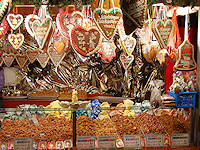
Typical Christmas market offerings.
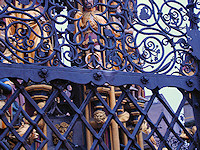
The Shöner Brunnen's Messingring.
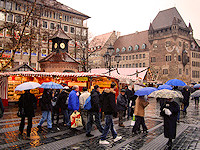
Lorenzplatz and the Nassauer
Haus.
|
|
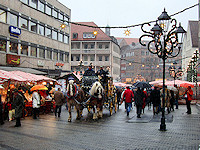
Carriage rides in the Altstadt.
|
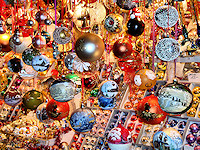
Hand-painted tree ornaments
for sale.
|
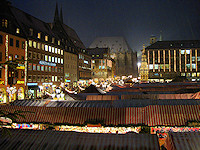
The Christkindlesmarkt in Nürnberg.
|
|
Copyright © 2005 JnDsTravelog.com. All rights reserved. |
| |